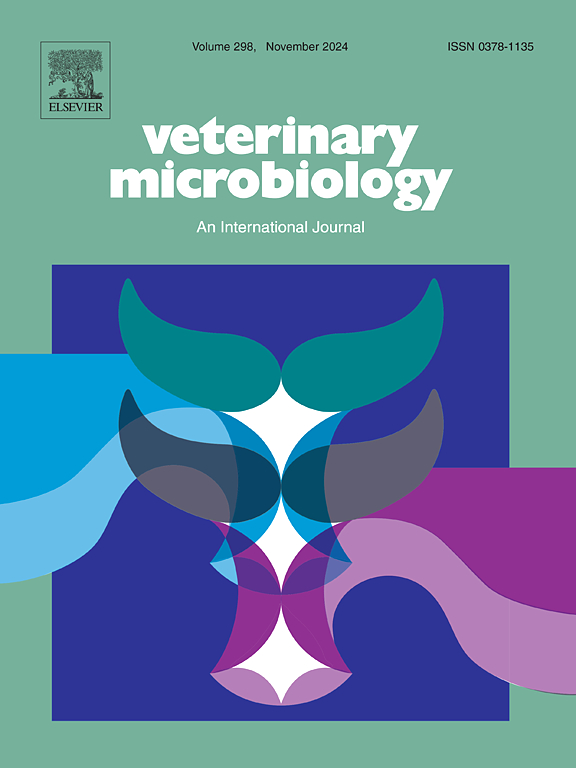胰蛋白酶对衣壳前体的蛋白水解加工是猪星状病毒体外感染和分离的必要条件
IF 2.4
2区 农林科学
Q3 MICROBIOLOGY
引用次数: 0
摘要
猪星状病毒(PAstV)在世界范围内流行,引起无症状、肠道或神经系统临床症状。然而,目前对PAstV的成熟机制和生命周期要素仍知之甚少,这给PAstV的分离和致病性研究带来了障碍。先前的研究报道了PAstV在PK-15细胞中的分离和复制需要添加胰蛋白酶,但该蛋白酶的详细作用尚未揭示。在本研究中,我们发现胰蛋白酶可以增强PAstV的细胞病变效应和RNA复制。衣壳前体,约90 kDa (VP90),可以直接释放到细胞外培养基中,随后被胰蛋白酶加工成约25 (VP25), 27 (VP27), 30 (VP30)和34 (VP34) kDa的四种末端产物。这一切割过程被发现对PAstV的传染性至关重要,因为由未切割或未完全加工的衣壳前体蛋白组装的后代病毒失去了传染性。此外,非传染性的子代病毒在胰蛋白酶治疗后恢复传染性。与经历“VP90-VP70”切割过程的人类星状病毒不同,细胞内半胱天冬酶被发现促进了PAstV-GX1病毒的释放,但不是必需的。病毒纯化证实,VP34、VP30和VP27构成成熟的、具有传染性的病毒颗粒。重要的是,在胰蛋白酶浓度下充分加工,产生VP27、VP30和VP34,被证明是PAstV成熟病毒粒子的组成部分。一般来说,PAstV的传染性严格依赖于细胞外胰蛋白酶将其衣壳前体VP90切割成VP25/27/30/34,绕过了在人类星状病毒中发现的细胞内“VP90- vp70”通路——一种新的星状病毒成熟策略。本文章由计算机程序翻译,如有差异,请以英文原文为准。
Proteolytic processing of the capsid precursor by trypsin is essential for porcine astrovirus infectivity and isolation in vitro
Porcine astroviruses (PAstV) have been prevalent worldwide, causing asymptomatic, intestinal or neurological clinical symptoms. However, the maturation mechanism and elements of the PAstV life cycle remains largely unknown, which poses an obstacle for PAstV isolation and pathogenic study. Previous studies have reported that PAstV’s isolation and replication in PK-15 cells requires the addition of trypsin, yet the detailed role of this protease has not been revealed. In this study, we found that trypsin could enhance the cytopathic effects and RNA replication of PAstV. The capsid precursor, of ∼90 kDa (VP90), could directly release into the extracellular culture media and subsequently processed by trypsin into four terminal products of about 25 (VP25), 27 (VP27), 30 (VP30) and 34 (VP34) kDa. This cleavage process was found to be essential for the infectivity of PAstV, as progeny viruses assembled from un-cleaved or incomplete processed capsid precursor protein lost its infectivity. Moreover, non-infectious progeny viruses regain infectivity after trypsin treatment. Unlike human astrovirus, which undergoes a "VP90-VP70" cleavage process, intracellular caspases were found to promote but are not required for PAstV-GX1 viral release. Virus purification confirmed that the VP34, VP30 and VP27 constitute mature, infectious viral particles. Importantly, sufficient processing under trypsin concentration, which produce VP27, VP30 and VP34, were proved to be components of PAstV mature virions. In general, PAstV's infectivity strictly depends on extracellular trypsin cleavage of its capsid precursor VP90 into VP25/27/30/34, bypassing the intracellular "VP90-VP70" pathway seen in Human Astrovirus—a novel maturation strategy in astroviruses.
求助全文
通过发布文献求助,成功后即可免费获取论文全文。
去求助
来源期刊

Veterinary microbiology
农林科学-兽医学
CiteScore
5.90
自引率
6.10%
发文量
221
审稿时长
52 days
期刊介绍:
Veterinary Microbiology is concerned with microbial (bacterial, fungal, viral) diseases of domesticated vertebrate animals (livestock, companion animals, fur-bearing animals, game, poultry, fish) that supply food, other useful products or companionship. In addition, Microbial diseases of wild animals living in captivity, or as members of the feral fauna will also be considered if the infections are of interest because of their interrelation with humans (zoonoses) and/or domestic animals. Studies of antimicrobial resistance are also included, provided that the results represent a substantial advance in knowledge. Authors are strongly encouraged to read - prior to submission - the Editorials (''Scope or cope'' and ''Scope or cope II'') published previously in the journal. The Editors reserve the right to suggest submission to another journal for those papers which they feel would be more appropriate for consideration by that journal.
Original research papers of high quality and novelty on aspects of control, host response, molecular biology, pathogenesis, prevention, and treatment of microbial diseases of animals are published. Papers dealing primarily with immunology, epidemiology, molecular biology and antiviral or microbial agents will only be considered if they demonstrate a clear impact on a disease. Papers focusing solely on diagnostic techniques (such as another PCR protocol or ELISA) will not be published - focus should be on a microorganism and not on a particular technique. Papers only reporting microbial sequences, transcriptomics data, or proteomics data will not be considered unless the results represent a substantial advance in knowledge.
Drug trial papers will be considered if they have general application or significance. Papers on the identification of microorganisms will also be considered, but detailed taxonomic studies do not fall within the scope of the journal. Case reports will not be published, unless they have general application or contain novel aspects. Papers of geographically limited interest, which repeat what had been established elsewhere will not be considered. The readership of the journal is global.
 求助内容:
求助内容: 应助结果提醒方式:
应助结果提醒方式:


